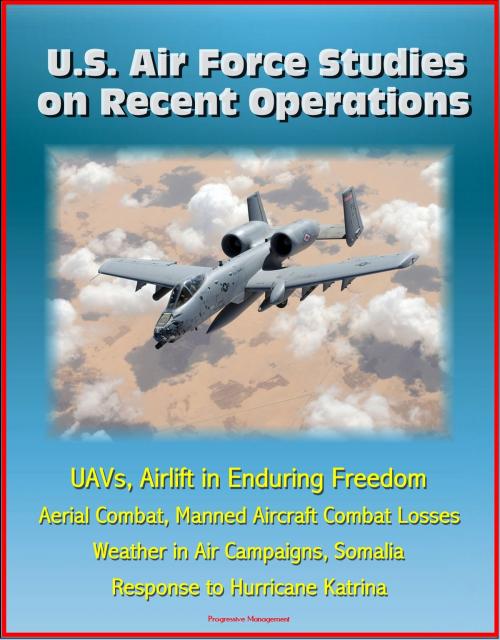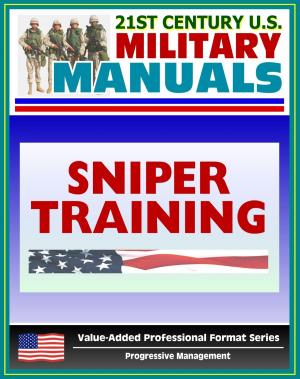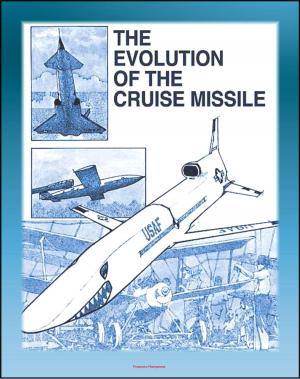U.S. Air Force Studies on Recent Operations: UAVs, Airlift in Enduring Freedom, Aerial Combat, Manned Aircraft Combat Losses, Weather in Air Campaigns, Somalia, Response to Hurricane Katrina
Nonfiction, History, Military, Aviation, United States| Author: | Progressive Management | ISBN: | 9781301143399 |
| Publisher: | Progressive Management | Publication: | December 10, 2012 |
| Imprint: | Smashwords Edition | Language: | English |
| Author: | Progressive Management |
| ISBN: | 9781301143399 |
| Publisher: | Progressive Management |
| Publication: | December 10, 2012 |
| Imprint: | Smashwords Edition |
| Language: | English |
This is a collection of eight U.S. Air Force studies on recent operations, providing unique insights into important issues involving the Air Force.
Contents: PART 1: A COUNTRY TOO FAR: U.S. MILITARY OPERATIONS IN SOMALIA, 1992-1994 * PART 2: WEATHER IN AIR CAMPAIGNS, 1990-2003 * PART 3: USAF MANNED AIRCRAFT COMBAT LOSSES 1990-2002 * PART 4: NO CONTEST: AERIAL COMBAT IN THE 1990s * PART 5: INTERTHEATER AIRLIFT CHALLENGES OF OPERATION ENDURING FREEDOM * PART 6: USAF PSYCHOLOGICAL OPERATIONS, 1990-2003 * PART 7: U.S. UNMANNED AERIAL VEHICLES IN COMBAT, 1991-2003 * PART 8: THE US AIR FORCE RESPONSE TO HURRICANE KATRINA
The chapter on unmanned aerial vehicles executive summary: Between 1991 and 2003, the United States used a variety of unmanned aerial vehicles (UAVs) in combat operations. These included the Pioneer, the Pointer, the Hunter, the Predator, the Global Hawk, the Dragon Eye, the Desert Hawk, and the Shadow. During those thirteen years the role of UAVs expanded from mere reconnaissance to target designation and attack. Advantages of UAVs over manned aircraft systems include eliminating pilot risk, saving money, providing long-term realtime video reconnaissance, and reducing the time between target identification and destruction. UAVs are especially useful for extremely long reconnaissance missions and for missions in areas of extreme danger. The percentage of unmanned aircraft sorties should continue to grow as UAV capabilities increase.
This is a collection of eight U.S. Air Force studies on recent operations, providing unique insights into important issues involving the Air Force.
Contents: PART 1: A COUNTRY TOO FAR: U.S. MILITARY OPERATIONS IN SOMALIA, 1992-1994 * PART 2: WEATHER IN AIR CAMPAIGNS, 1990-2003 * PART 3: USAF MANNED AIRCRAFT COMBAT LOSSES 1990-2002 * PART 4: NO CONTEST: AERIAL COMBAT IN THE 1990s * PART 5: INTERTHEATER AIRLIFT CHALLENGES OF OPERATION ENDURING FREEDOM * PART 6: USAF PSYCHOLOGICAL OPERATIONS, 1990-2003 * PART 7: U.S. UNMANNED AERIAL VEHICLES IN COMBAT, 1991-2003 * PART 8: THE US AIR FORCE RESPONSE TO HURRICANE KATRINA
The chapter on unmanned aerial vehicles executive summary: Between 1991 and 2003, the United States used a variety of unmanned aerial vehicles (UAVs) in combat operations. These included the Pioneer, the Pointer, the Hunter, the Predator, the Global Hawk, the Dragon Eye, the Desert Hawk, and the Shadow. During those thirteen years the role of UAVs expanded from mere reconnaissance to target designation and attack. Advantages of UAVs over manned aircraft systems include eliminating pilot risk, saving money, providing long-term realtime video reconnaissance, and reducing the time between target identification and destruction. UAVs are especially useful for extremely long reconnaissance missions and for missions in areas of extreme danger. The percentage of unmanned aircraft sorties should continue to grow as UAV capabilities increase.















